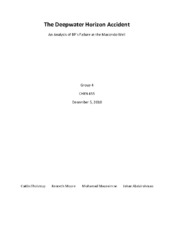| dc.description.abstract | The overall objective of this report is to document and analyze the series of events leading up to the explosion of the Deepwater Horizon and the responses to the explosion with regard to the safety measures and protocols followed during the accident. The history of BP is discussed with regard to accidents caused by failure to comply with established safety procedures, including the Texas City Refinery Explosion in 2005, the Alaskan Oil Spill in 2006, and then the eventual Deepwater Horizon explosion in 2010. An analysis of these events show that negligence and malpractice conducted on BP’s part led to the aforementioned disasters. This foreshadows the events of the Macondo well in which negligence (on both BP’s and the United States Government’s part) and financial stress induced the failure of mechanical barriers to seeping hydrocarbons into the drill pipe. Though the Deepwater Horizon rig belonged to Transocean and the cement job was performed by Halliburton, the lease operator for the Macondo well was BP and thusly is assigned an overwhelming majority of the blame for the catastrophic explosion. At least 8 layers of safety were breached, demonstrating a severe lack of responsibility on behalf of BP and the personnel aboard the Deepwater Horizon.
Following the explosion, the United States Government and the public had an ever-increasing tension-filled relationship with BP as the well gushed oil at an average of 70,000 barrels of oil per day for 87 days. Despite BP desiring to be transparent with the public and the government, BP was ultimately fined billions of dollars in damages and lost wages. Even though the spill has been capped and cleanup efforts have made considerable progress, the reputation of BP will never be what it used to be, especially after the two previous disasters before the explosion of Deepwater Horizon. Its status as one of the leading oil producers in the world is forever tarnished after this accident.
A similar accident occurring in Bhopal, India in 1984 is also analyzed. Though the accident in Bhopal involves the toxic and fatal release methyl isocyanate (MIC) vapors instead of flammable hydrocarbons, analogues between the Bhopal incident and the Deepwater Horizon incident are readily observed. Both incidents involve the responsible company not following proper safety measures due to financial stress and negligence. While BP is being held fully accountable by the United States Government, the former company Union Carbide did not suffer nearly the same amount of punishment for thousands of victims the Bhopal incident claimed. Nevertheless, both incidents reveal the consequences of malpractice and negligence on behalf of the operating company. To ensure that the engineering profession is not tainted by theses travesties, stricter and more thorough practices of safety measures and procedures must be followed in future engineering endeavors. | en |



